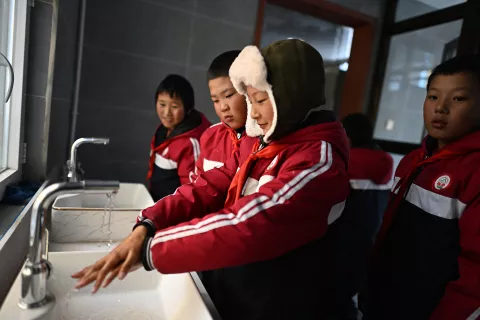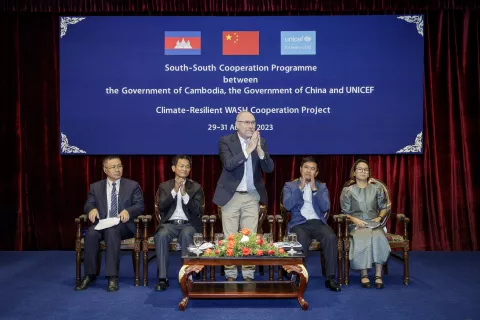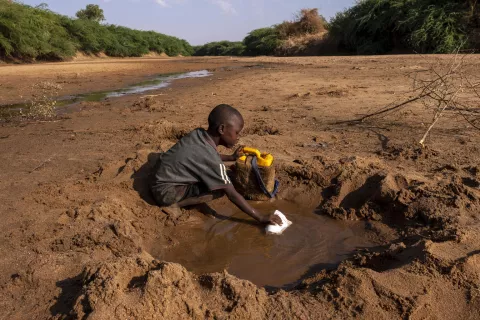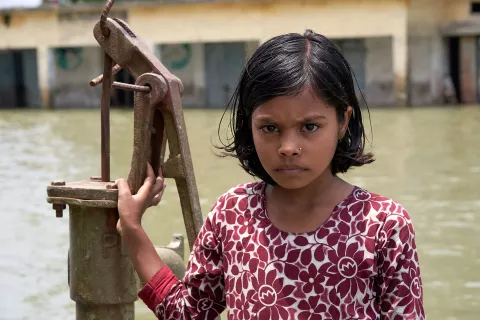One in five children globally does not have enough water to meet their everyday needs – UNICEF
UNICEF launches new initiative, Water Security for All, to mobilize global support and resources to reach children in water vulnerable hotspots
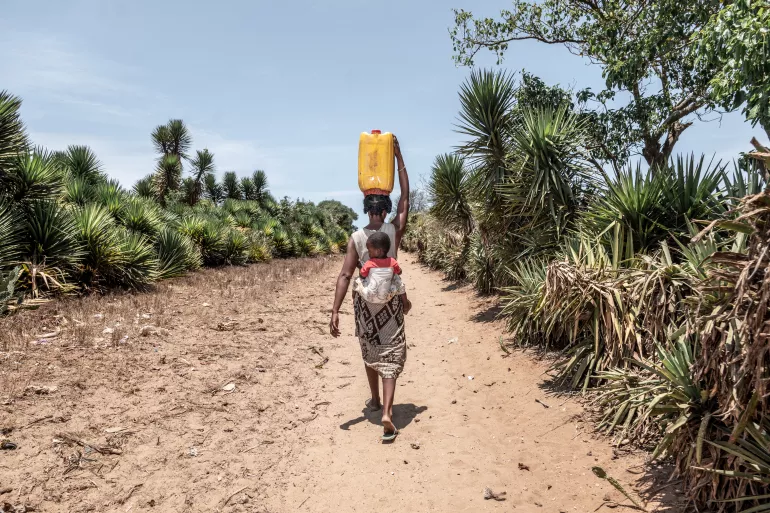
- Available in:
- 中文
- English
NEW YORK, 18 March 2021 – Globally, more than 1.42 billion people, including 450 million children, live in areas of high, or extremely high, water vulnerability, according to a new analysis released by UNICEF. This means that 1 in 5 children worldwide does not have enough water to meet their everyday needs.
The analysis, part of the Water Security for All initiative, identifies areas where physical water scarcity risks overlap with poor water service levels. Communities living in these areas depend on surface water, unimproved sources, or water which can take more than 30 minutes to collect.
"The world's water crisis is not simply coming, it is here, and climate change will only make it worse," said UNICEF Executive Director Henrietta Fore. "Children are the biggest victims. When wells dry-up, children are the ones missing school to fetch water. When droughts diminish food supplies, children suffer from malnutrition and stunting. When floods hit, children fall ill from waterborne illnesses. And when water resources decline, children cannot wash their hands to fight off diseases."
The data shows that children in more than 80 countries live in areas with high or extremely high water vulnerability. Eastern and Southern Africa has the highest proportion of children living in such areas, with more than half of children – 58 per cent – facing difficulty accessing sufficient water every day. It is followed by West and Central Africa (31 per cent), South Asia (25 per cent), and the Middle East (23 per cent). South Asia is home to the largest number of children living in areas of high or extremely high water vulnerability – more than 155 million children.
Children in 37 ‘hotspot’ countries face especially dire circumstances in terms of absolute numbers, the proportions of children affected, and where global resources, support and urgent action must be mobilized. This list includes Afghanistan, Burkina Faso, Ethiopia, Haiti, Kenya, Niger, Nigeria, Pakistan, Papua New Guinea, Sudan, Tanzania and Yemen.
Demand for water continues to increase dramatically while resources are dwindling. In addition to rapid population growth, urbanization, water misuse and mismanagement, climate change and extreme weather events reduce available quantities of safe water, exacerbating water stress. According to a UNICEF report from 2017, almost 1 in 4 children globally will live in areas of extremely high water stress by 2040.
While the impact of water scarcity can be felt by all, no one suffers more than the most vulnerable children. Children and families living in vulnerable communities face the double-edged sword of coping with high water scarcity levels while having the lowest water services, making access to sufficient water especially susceptible to climate shocks and extreme events.
In response, UNICEF is launching the Water Security for All initiative to ensure every child has access to sustainable and climate-resilient water services. The initiative aims to mobilize resources, partnerships, innovation and global response to identified hotspots where the need for safe, resilient and sustainable water, sanitation and hygiene services is the greatest and most urgent.
UNICEF is working to provide:
- Safe and affordable drinking water services: Access to safe and affordable water services that are sustainable, close to home, and managed professionally.
- Climate-resilient water, sanitation and hygiene services and communities: Water, sanitation and hygiene services that withstand climate shocks, operate using low carbon energy sources, and strengthen communities' resilience and adaptive capacities.
- Early action to prevent water scarcity: Resource assessments, sustainable water withdrawal, efficient use, and early warning and early preventative measures.
- Water cooperation for peace and stability: Support to communities and key stakeholders so that equitable management of water, sanitation and hygiene services increase social cohesion, political stability and peace; and in conflict zones to prevent attacks on water and sanitation infrastructure and personnel.
"We have to act now both to address the water crisis and to prevent it from getting any worse,” said Fore. “We can only achieve water security for every child through innovation, investment and collaboration, and by ensuring services are sustainable and resilient to climate shocks. For our children and our planet, we have to act.”
#####
Notes to editors
* Countries designated as ‘hotspots’ meet any of the following criteria: At least 60% of children live in areas of high water vulnerability; at least 40% of children live in areas of extremely high water vulnerability; at least 40% of children live in high and extremely high water vulnerability; and at least 2 million children in high and extremely high water vulnerability. These range of factors ensure that even smaller countries with high percentages of children affected also get prioritised.
Water scarcity: Water scarcity exists where the demand for water exceeds supply and where available water resources are approaching or have exceeded sustainable limits. Water scarcity can either be physical or economic.
Water stress: Water stress is an outcome of water scarcity and refers to scarcity in terms of quality and accessibility of water. Water stress may manifest in conflict over water resources, over-extraction, or poor health and disease.
Extreme water vulnerability: Extreme water vulnerability is the combination of the highest levels of physical water scarcity and lowest levels of drinking water service that affects a given population (surface water, unimproved or limited water service).
Water security: The capacity of a population to safeguard sustainable access to adequate quantities of and acceptable quality water for sustaining livelihoods, human well-being, and socio-economic development, for ensuring protection against water-borne pollution and water-related disasters, and for preserving ecosystems in a climate of peace and political stability. Water insecurity occurs when any or all of these needs cannot be met.
Download multimedia content here
Read more about Water Security for All
Media contacts
About UNICEF
UNICEF works in some of the world's toughest places, to reach the world's most disadvantaged children. Across 190 countries and territories, we work for every child, everywhere, to build a better world for everyone.
| Visit UNICEF Global website: www.unicef.org Visit UNICEF China website: www.unicef.cn Follow us on Sina Weibo: http://weibo.com/unicefchina Wechat: unicefchina |


